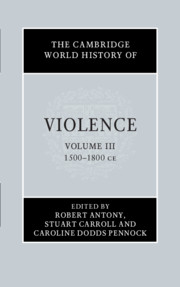Book contents
- The Cambridge World History of Violence
- The Cambridge World History of Violence
- The Cambridge World History of Violence
- Copyright page
- Contents
- Figures
- Maps
- Contributors to Volume iii
- Introduction to Volume iii
- Part I Empire, Race and Ethnicity
- Part II Cultures of War and Violence
- Part III Intimate and Gendered Violence
- Part IV The State, Punishment and Justice
- Part V Popular Protest and Resistance
- Part VI Religious and Sacred Violence
- 25 Religion and Violence in East Asia
- 26 Violence towards Heretics and Witches in Europe, 1022–1800
- 27 Intercommunal Violence in Europe
- 28 Violence, Animals and Sport in Europe and the Colonies
- Part VII Representations and Constructions of Violence
- Index
- References
26 - Violence towards Heretics and Witches in Europe, 1022–1800
from Part VI - Religious and Sacred Violence
Published online by Cambridge University Press: 13 March 2020
- The Cambridge World History of Violence
- The Cambridge World History of Violence
- The Cambridge World History of Violence
- Copyright page
- Contents
- Figures
- Maps
- Contributors to Volume iii
- Introduction to Volume iii
- Part I Empire, Race and Ethnicity
- Part II Cultures of War and Violence
- Part III Intimate and Gendered Violence
- Part IV The State, Punishment and Justice
- Part V Popular Protest and Resistance
- Part VI Religious and Sacred Violence
- 25 Religion and Violence in East Asia
- 26 Violence towards Heretics and Witches in Europe, 1022–1800
- 27 Intercommunal Violence in Europe
- 28 Violence, Animals and Sport in Europe and the Colonies
- Part VII Representations and Constructions of Violence
- Index
- References
Summary
After 600 years without executions of heretics, several were burned in France in 1022. Persecutions, erratic across western Europe, remained rare in Orthodox lands. Debate continues over whether large medieval heretical movements existed or were inflated by authorities seeking an excuse to assert their authority. Hunts for heretics turned into witchcraft trials by the late 1300s. Soon a stereotype of the witch insisted that she rejected Christianity and committed evil acts at the devil’s command. Witch hunts then occurred in various lands, especially along the Rhine in 1580–90 and 1620–30. Such persecutions, also erratic, never took place in many areas. The relatively few Russian cases rarely mentioned alliance with Satan. Both strains of persecution arose in western Europe by the eleventh century as fear worsened of enemies within Christendom. The church strengthened its influence, making heresy identifiable. In Catholic and Protestant regions witch hunts arose when villagers accused their neighbours of foul deeds and the local elite seized on the witch stereotype. But authorities often rejected that image, while central officials in Sweden, for instance, halted trials. Thus, it is doubtful that the hunts had the intention or effect of terrorising women, instilling social discipline among peasants or strengthening the state. They ended as objections grew that evidence for witchcraft was weak or conjectural.
- Type
- Chapter
- Information
- The Cambridge World History of Violence , pp. 513 - 530Publisher: Cambridge University PressPrint publication year: 2020



